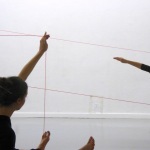The start of the 60_minutes series was a calm one. Akemi Nagao, standing motionless on stage, brings the entering audience into stillness. Unrequestet, people take their shoes off to muffle the sound of their steps. This way to begin the show is not surprising yet. The nice surprise is however, that this time it is not just a teaser, not a stillness which is established just to be soon broken. It is a real prologue: it contains already the mood and the timing of the whole composition, which explores the phanomenon of the line. There is no reason to hurry while dealing with the infinity. Long phases of stillnes, slow changes of spatial constellations, and almost a complete silence will remain dominant characteristics of the performance. Some more sudden movements or changes are embed into the calm and sustained frame. At the beginning the two moving bodies (Akemi Nagao and Elma Riza) seem to relate to some invisible structures. The action of the visual artist Aurélie Pertusot, brings the revelation: she stretches some red threades and ribbons across the space, she reveals some diagonals of invisible volumes, sketches a minimalistic landscape of curve diagramms. The quality of her movement – pedestrian, expedient, matter-of-factly – is contrasting the physical performance of the movers, who are exploring their body shapes and shape changes in relation to the changing geometrical setting.
The meeting between visual arts and physical performance is an insightful one. Some key features of the project are adopted from the visual arts: like the endurance while crafting and displaying still forms and shapes, or like naturally granting the artist the authority of the demiurgic gesture. Or like allowing the simple beauty of geometric patterns.
As the curator I’m asking myself the question: how does the “In Between” project relate to the 60_minutes concept? How is the duration relevant for this particular artistic process? While watching I’ve understood, that the subheading “work in progress” doesn’t mean the typical: we are not quite ready by now. This work is about the lines and as every line can infinitely progress in space (at least when we are still in the Euclidean space), the project can – at least theoretically – be infinitely in progress, exploring the endless variations of the possibly simple structure. So every performance, regardless of its duration, can exhibit the next portion of the progress. In fact, when Elma Riza shows her comparable solo work in art galeries, the installation/performance is open for three hours. However, the audience there is an “art audience”: it is mobile and decides on its own how long should the encounter with the artwork last. To work with the “fixed” theater audience for one hour with the similar minimalistic score poses a different art of interplay. The artists decided to divide the timeframe into three sections or modules, every time starting with a new geometrical setting. So maybe it could go on shorter or longer, one module, two modules, five modules just as well? I think it could, but it would be different. Even if the geometry may stay in its variability basically same, the bodies and minds involved on both sides of the stage are affected by the duration. There is a matter of expectation and projection, which influence the instant composition. There is the accumulation of experience, which leads to new artistic decisions. I stay excited by watching how the artists cope with the duration. jagna anderson
In Between. Work in Progress / #1
14 Februar 2015 | 20 h | Mime Centrum Berlin
Akemi Nagao, Aurélie Pertusot, Elma Riza







2 Comments
Comments are closed.